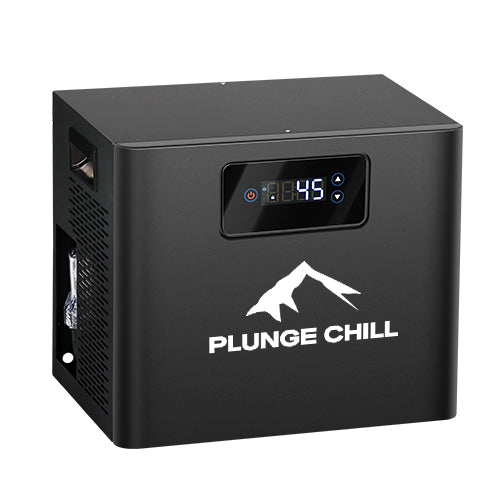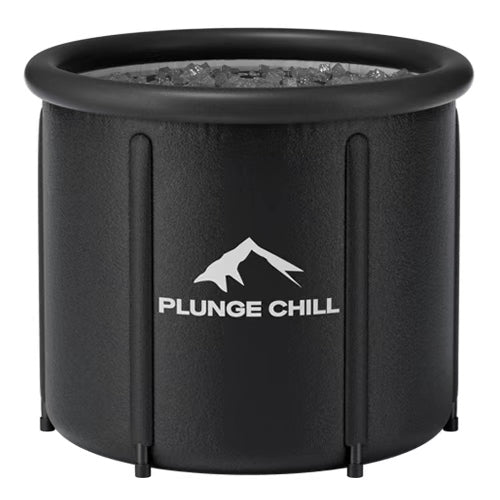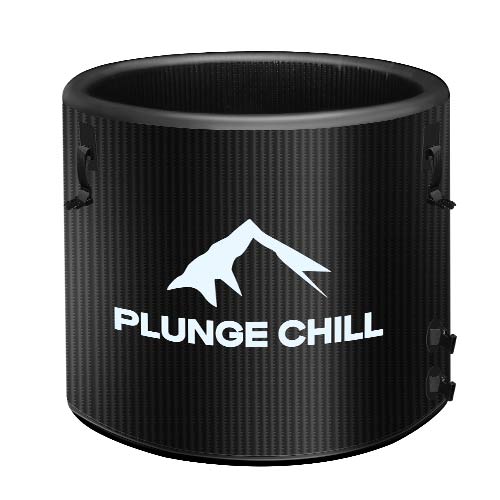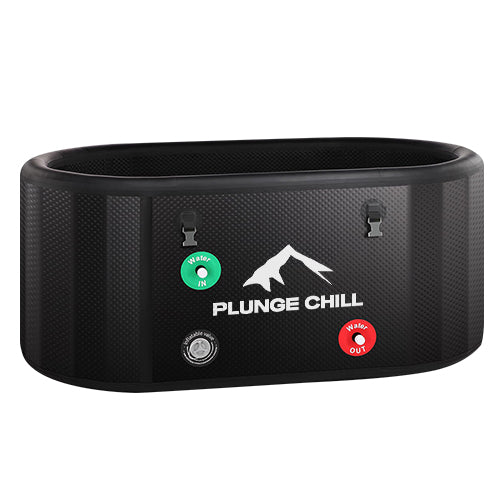One minute you're scrolling through Instagram watching celebrities and athletes rave about ice baths, the next you're wondering if you should try it yourself. But here's what they don't always mention: without proper safety knowledge, that refreshing cold plunge could land you in the emergency room.
Ice bath therapy offers incredible benefits: faster muscle recovery, better mood, improved sleep, and enhanced mental toughness. However, knowing how to do it safely is what separates a life-changing wellness practice from a dangerous mistake.

Before You Even Touch the Ice: Is This for You?
Your body's response to cold water is powerful and immediate, which makes it crucial to know if you're actually a good candidate for ice bath therapy.
Some people face serious risks that outweigh any potential benefits:
- If you have heart problems: Your heart will work overtime in cold water, and blood pressure can spike dangerously and trigger irregular rhythms. This isn't worth risking a heart attack for faster recovery.
- If you're pregnant: Cold water reduces blood flow to your baby and puts stress on your body when it's already working hard. Your baby's safety comes first, so wait until after delivery.
- If you have Raynaud's disease (a condition where your fingers and toes get extremely cold and numb): Your fingers and toes already struggle with cold, and ice baths can trigger severe pain and cut off blood flow completely. You could lose feeling for hours or damage tissue.
- If you have open wounds or infections: Cold water will slow your healing to a crawl and bacteria love dirty ice bath water. You'll end up with worse infections that take weeks longer to heal.
- If you have young children around: Kids can drown silently in just inches of water, and they lose body heat faster than adults. Never leave ice bath equipment accessible to unsupervised children!
Setting the Scene: How to Prepare for a Safe Plunge

Even if you're cleared for cold water therapy, rushing into an ice bath without proper setup is asking for trouble. The difference between a great session and a bad one often comes down to what you do before you get in.
Smart Setup for a Safe Space
First, think about your location. You'll want your tub on a flat, stable surface where it won't wobble or tip. The area around it should be clear of clutter: no rugs, shoes, or electrical cords that you could trip over when you’re getting in or out.
Good lighting is also more important than you might think. You need to be able to see clearly, not just for footing, but to check your skin for warning signs.
Keep It Clean
Always start with fresh, clean water for each session. Standing water is a breeding ground for bacteria, and you don't want to soak in that. While some modern cold plunge chillers have built-in filtration (like Plunge Chill Water Chiller) that keeps water clean for longer, the golden rule is always to prioritize hygiene.
Gather Your Safety Gear
Have these three essentials within arm’s reach before you get in:
A Thermometer: Don't just guess the ice bath temperature. Your perception of cold can be wildly inaccurate. A simple floating digital thermometer takes the guesswork out and lets you know exactly what you're dealing with.
If you're serious about regular practice, Plunge Chill's cold plunge chiller with built-in temperature control can save you the dangerous guesswork.
- A Timer: When you're in the cold, your sense of time can get distorted. A minute can feel like an eternity. Use your phone or a simple kitchen timer with an alarm so you don't stay in too long by accident.
- Warm Towels: Have a big, fluffy towel (or two) right next to the tub. The moment you get out, you'll want to dry off and warm up immediately.

Hydrate and Fuel Properly
Drink a good 16-20 ounces of water an hour or two before your plunge. When you're dehydrated, your body has a harder time regulating its temperature, which increases your risk.
It's also wise to skip alcohol for at least 12 hours beforehand and limit caffeine on the day of your plunge. Both can interfere with your body's natural response to cold and mess with your heart rate.
Never Plunge Alone
Especially when you're starting out, have someone else nearby. Make sure they know the warning signs of a problem, and are ready to help you get out or call for emergency services if needed.
The Perfect Plunge: Your 6-Step Guide
You’ve done your prep, your space is safe, and you're ready to go. How you actually enter and experience the ice bath is what makes all the difference.
The Basic Flow:

Step 1: Know Your Numbers (Before You Get In)
For your first few sessions, aim for a water temperature between 60−65°F. This might sound warmer than what you see online, but it's the perfect starting point. Set your timer for just 60 to 120 seconds. It's always better to start short and easy. You can build up time and lower the temperature as your body adapts.
Step 2: Enter Gradually (Don't Shock Your System)
Never jump or dive in. A gradual entry gives your body a moment to adjust.
- Start by putting just your feet in for 10-15 seconds.
- Slowly lower yourself in up to your knees and pause again. Take a few steady breaths.
- Lower yourself to waist-deep. This is where you'll feel the intensity of the cold shock the most. Stay calm.
- If you feel in control, you can lower yourself until the water is at your shoulders.
- Unless you are very experienced and have a spotter, always keep your head above water.
Step 3: Master the First 60 Seconds
The moment your torso hits the cold water, your body will instinctively gasp for air and you'll feel the urge to breathe too fast and shallow. This is the "cold shock response," and it's completely normal. Your job isn't to fight it, but to manage it.
- Focus on your breathing. Take short, controlled exhales. Think "huff, huff, huff."
- Gently move your hands and feet in the water.
- Remind yourself, "This is just a feeling, and it will pass." Because it will, usually within 45-60 seconds.
Step 4: Find Your Calm (After the Shock Passes)
Once that initial gasping sensation subsides, your focus should shift.
- Transition to slower, deeper breathing. A simple box breath (4 seconds in, hold for 4, 4 seconds out, hold for 4) or a longer exhale (4 counts in, 6 counts out) can be very effective at calming your nervous system.
- Consciously relax your jaw, neck, and shoulders.
- Find a mental anchor—focus on your breath, a positive mantra, or a calm image in your mind.
Step 5: Listen to Your Body and Exit Smart
Pay close attention to your body's signals.
Good signs to stay in:
✓ Your breathing feels calm and under control.
✓ You feel mentally alert and present.
✓ Your skin is tingling, but you have no significant pain or numbness.
✓ You could hold a normal conversation.
Warning signs to get out immediately:
⚠️ Shivering becomes violent or uncontrollable.
⚠️ You feel any numbness in your limbs, fingers, toes, or face.
⚠️ You start to feel confused, dizzy, or have trouble thinking.
⚠️ Your skin starts to turn blue or gray (some pink or redness is normal).
⚠️ You still can't get your breathing under control after the first couple of minutes.
Step 6: The Exit Strategy
When your timer goes off or your body tells you it's time, get out carefully. Stand up slowly, as you might feel a bit lightheaded. Step out onto a non-slip surface and immediately grab that warm towel you set out.

After the Plunge: The Crucial Recovery Phase
Getting out of the water is only half the battle. Your rewarming protocol is just as important for safety and for maximizing the benefits of your session.
Get Out and Dry Off Fast
Exit slowly to avoid dizziness, then immediately wrap yourself in warm, dry towels. Change out of wet clothes right away - they'll keep cooling your body.
Move Gently
Light walking or stretching helps restore blood flow. Avoid intense exercise that could stress your heart. Focus on moving your fingers and toes to get blood flowing.
Warm Up Gradually
Layer on dry clothes rather than bundling up immediately. Drink warm (not hot) beverages like herbal tea. Avoid alcohol, which interferes with proper rewarming.
Monitor Yourself
Keep checking how you feel for the next hour. Some people get energized, others feel tired - both are normal. Persistent shivering, confusion, or feeling unwell means you should see a doctor.
When Things Go Wrong: Handling Emergencies
Most ice bath sessions go smoothly when you follow safety protocols, but knowing how to handle emergencies could save your life or someone else's. Cold shock can develop faster than you think, especially in beginners who push too hard too fast.
Recognize the Warning Signs of Cold Shock:
- Intense, uncontrollable shivering that won't stop even after getting out.
- Slurred speech, mumbling, or confusion.
- Clumsiness or loss of coordination.
- Skin that appears blue, gray, pale, or blotchy.
- Extreme drowsiness or weakness.
What to Do in an Emergency:
- Get the person out of cold water immediately
- Call 911 if symptoms are severe
- Move to a warm, dry place
- Remove wet clothes gently
- Wrap in warm blankets (avoid direct heat like heating pads)
- Give warm drinks if the person is conscious and alert
- Monitor breathing and be ready to do CPR
What NOT to Do: Never use direct heat like a hot shower, a heating pad, or a fire to warm someone up. These can cause dangerous blood pressure changes or heart rhythm problems.
Your First Plunge Awaits
Remember those videos that got you curious in the first place? The real strength shown by the people in them isn't about being tough, it's about being smart and consistent. Safety is the foundation of a successful cold plunge practice. When you respect the cold, it respects you back with a host of benefits.
Ready to give it a try? Start with a comfortable 60°F for 60 seconds this week. Listen to your body, follow these steps, and check out Plunge Chill Cold Plunge Chiller for better results.
FAQs About Ice Bath Safety
Q1: What's the biggest mistake beginners make?
Going too cold, too fast. Your Instagram feed is full of people in 40°F water, but they didn't start there. Begin at 60-65°F and earn your way down.
Q2: How do I know if I'm actually getting benefits or just torturing myself?
Real benefits feel like increased energy, better mood, and faster recovery. If you're just suffering through it with no positive effects after 2-3 weeks, you're probably pushing too hard.
Q3: Is expensive equipment really necessary?
For occasional use, a basic setup works fine. But if you're planning regular sessions, quality equipment with temperature control prevents the guesswork that leads to accidents.
Q4: What's the one thing that would make you tell someone to stop immediately?
If they can't control their breathing after the initial 60-second shock period, they need to get out. Breathing control is your canary in the coal mine for ice bath safety.








